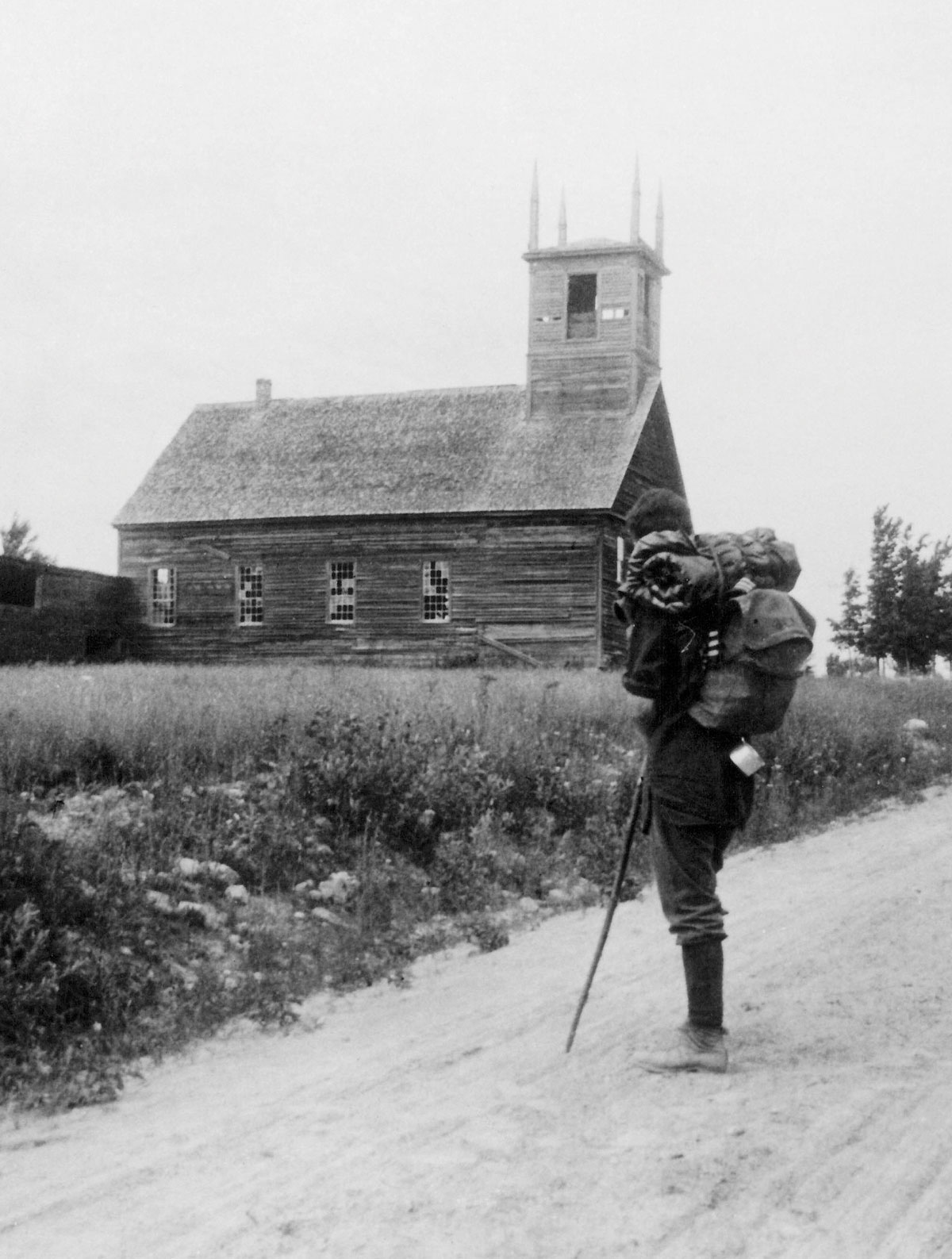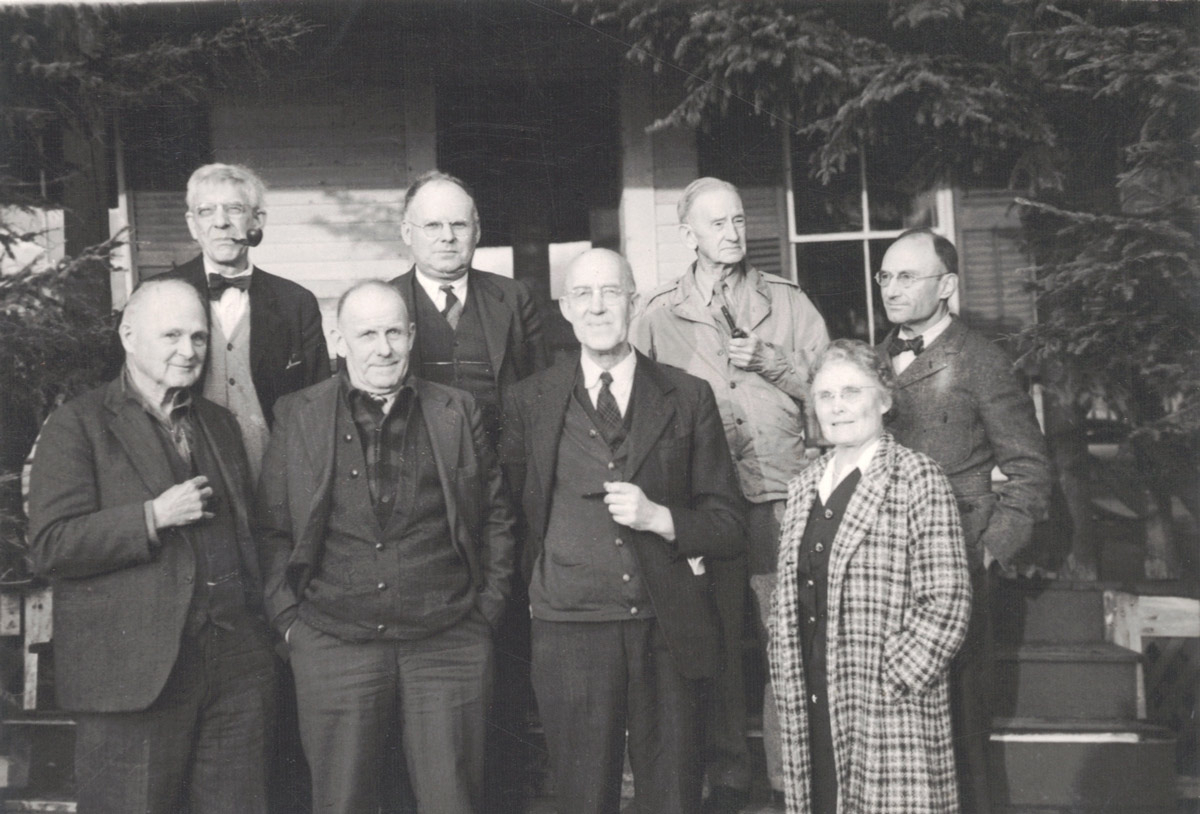
Photo courtesy of Dartmouth College Library
rmchair trail advocate. Avant-garde conservationist. Conservation’s inseminator. Craggy New Englander. Cultural democrat. Eccentric. Ecologist. Failure. Head in the clouds. Humanist. Incidental naturalist. Incorrigible optimist. Journalist. Mayflower descendant. Naturalist. Nestor of the Appalachian Trail. Nineteenth-Century Romantic. Political radical. Prophet. Regional planner. Sage of Shirley Center. Single-taxer. Socialist. Unemployed. Utopian Socialist. Visionary. Wilderness advocate. Woodsman. “Forester, philosopher, and dreamer.”
That last description of Benton MacKaye came from Myron H. Avery and became the accepted “definition” in Appalachian Trail folklore and history for the next half-century or more, writings that set Avery apart as the “doer.”
Most of those descriptions are true but individually incomplete. Some are unfair, even false. Scores of doctoral dissertations containing such descriptions — and a number of books drawn from them — have attempted to define or pigeonhole MacKaye. Most of those papers have never made it into the Appalachian Trail Conservancy archives, much less into the long-held internal portraits of the progenitor of the A.T.
“What have I been doing for the past half-century? Well, I’ve been titled, officially or otherwise, a forester, a regional planner, a conservationist, a geographer, and an economist; once I was anointed engineer.
“To tell you the truth, my job has been called by every name except the right one—that would be whatever you’d call the job of making our fair land more fair and habitable. One way to do this is to prevent the land from oozing away entirely: hence erosion control, flood control, and forestry.
“The other way is to equip the land for living and guard against its decline into a series of hellholes; hence, preserving the open spaces, highway reform and — in general — regional planning.”
The idea that MacKaye, who publicly proposed the A.T. at age 42 and lived more than 96 years, wrote one article and otherwise sat in the shadows thinking deep thoughts is the first thing to be dispelled. In his papers at the Dartmouth College Library is a hand-written spreadsheet from about the time of that Harvard reunion, listing all his jobs (or not), employers, where he stayed, what he was paid, and reason for leaving. It is eight pages long, eight entries per page, until it stops in 1942 before he finished a Rural Electrification Administration posting in 1945 and then led for a few years the Wilderness Society he helped found.


The list does not appear to include the freelance writing that provided some occasional income to a monastic man, writing almost daily, who spent decades of his life in a Shirley Center, Massachusetts, house with no electricity, a woodstove for heat, and a pump for water, trying to also provide for his mother and sister. Then again, he also was well-known as a peripatetic house guest among his broad circle of friends and benefactors.
The notion that is the most unfair is that he merely stood aside from 1921 until Avery took charge of the A.T. project in 1930 and finished the completion of a flagged and mapped (only spottily “built”) footpath in 1937. MacKaye himself in 1975 modestly described that Roaring Twenties period as “years of conferring, routing, brush-cutting, mapping, consulting with Forest and Park Services.” He left out meetings at least annually at Hudson Guild Farm to brainstorm with his fellow planners.
In fact, the vast majority of the figures — volunteers and government officials — who constituted the central and local leadership associated with Avery were introduced to the A.T. project by MacKaye in the 1920s.
Biographer Larry Anderson writes of those labels and job titles:
“Snapshots of MacKaye’s writing and activities at particular junctures of his lengthy career might place him comfortably in standard scholarly pigeonholes labeled conservationist, preservationist, environmentalist, forester, regionalist, planner, or ecologist. Partly by virtue of his longevity, but primarily because he was motivated more by intuition and personal experience than by a systematic philosophy or discipline, such stereotypes do not prove very useful in MacKaye’s case.”
Still, what was he thinking, and where did it come from? It is helpful, when reading MacKaye’s article proposing an Appalachian Trail or the dozens of articles and three books he published or the scores of academic papers about him, to understand his language.
“Urban” is a lively city and could be good, if its cultural life were robust and its air clean.
“Metropolitan” is an urban settlement overtaken by industry and metastasizing into the countryside, inorganic, submerging life. MacKaye’s position was that the metropolis destroyed individuals and “indigenous” character — that would be the “problem of living” of which he writes: living to work, without work/life balance. He sometimes used “industrialized cities” without specific examples or reference to any such in which he lived.
“Indigenous” is the New England village like his beloved Shirley Center, Massachusetts, the best of environs and the cultural complement to a city (not to a metropolis). He never abandoned his proposition that such villages were the best of all worlds for man, forming the cambium or organic source for all human life. (MacKaye clearly considered what became New England, settled since perhaps 10,000 BCE, to be uninhabited by civilized humans prior to the Anglo-Saxon colonization of the 17th Century — more than an irony, since the Nipmuc indigenous to Shirley Center and other tribes reportedly were organized in the way he wished the world to be.)
“Primeval” is not the world as it was at creation but the forested summit seen from that village, the apex humans should seek out to elevate their vision and his own lifelong point of departure for imagining a different present through panoramic vision.
“Region” is a place not bounded by artificial, political boundaries but defined by watersheds or other physiographic features, such as the Appalachians or the Tennessee River Valley.
That vague, drab word “habitable” — much like “play” — appears constantly in his lifetime of writing, although what he means by it is elusive in essays that otherwise are full of the most active, flamboyant images fitting for the son and sibling of a theatrical family. His rhetoric, at times circumspect, also could tend toward the virile, masculine woodsman, even that of combat. Addressing this higher calling, Anderson notes that MacKaye in his The New Exploration (a book he considered a better description of his A.T. ideas than the article) declared the “ultimate human aspiration consists in one form or another of broadening our mental and spiritual horizon.”
“Wilderness” is another slippery word, today often reflexively associated with MacKaye and even the 1921 article, where it actually appears just once — to describe the southern Appalachians. He began using it more frequently in the early 1930s, often replacing “primeval” with it, as he became associated closely with Aldo Leopold, Bob Marshall, and other preservationists… although he was known to mock “pompous pansy planters.” He later said, oddly, that his first taste of wilderness was the fully logged over White Mountains he hiked through with college friends in 1897.
He came late to preservation, advocating in earlier years for planned, controlled development of the environment — through sustainably managed forestry, for starters — for human happiness rather than profit. In his 1965 doctoral dissertation, MacKaye editor Paul T. Bryant wrote, “He wishes to preserve for use, not to embalm. The first step in an activity that is to be in genuine harmony with the landscape…must be an effort to learn the physical, scientific facts about the development of the landscape…as an organic being always subject to a continuing process.”
And “recreation”? MacKaye meant re-creation, not necessarily hiking or camping or other activities, but instead spending time studying and absorbing nature to advance one’s mind and soul, seemingly his idea of “play.” In MacKaye’s own papers on his idea of an outdoor culture, he values applied science in geology and biology in the backcountry over aesthetics (except as it could inform art).
Still, whispering people want to know, was he really a socialist and the 1921 article a propaganda tract? Anderson and others document that he was a member of the Harvard Socialist Club, a number of his siblings and many of his friends and associates were Socialist Party members later, and his wife Betty’s last public appearance was sharing a stage with party leader Norman Thomas. However, especially in the 1920s, socialism had many genres; his brothers tended toward what’s termed market or utilitarian socialism. (Benton at least once referred to others’ utopian writings as pipe dreams.) Historian Paul Sutter suggests his approach was more of a socially informed or progressive conservation.
More importantly, MacKaye’s writings contain none of the conventional rubrics associated with that ideology. He emphasizes evolution over any form of economic or other revolution — promoting an era of balance and harmony among metropolis, village, and “primeval.” Rather than state ownership of production or any form of autocracy, he advocated using private industry as a means toward man’s higher ends (rather than the reverse). He always praises local, decentralized control rather than central control by government, which, as a longtime federal employee, he viewed as tending toward the bureaucratic.
In his colonization proposals (including parts of the A.T. idea), he wanted the government to own the land, build minimum roads to access it, and watch out for the caretaking resident workers’ safety but otherwise to stand back benignly. This was not a new idea for MacKaye: A Labor Department article he wrote in 1919 fully developed his notions of rural colonies for returning World War I soldiers — tied to federal or state land they would only emotionally own as their inner lives improved. He sometimes worried aloud about being tied to the new Bolsheviks he once flirted with from afar.

Appalachian Trail Conservancy Archives photo
In developing the 1921 article, MacKaye, editor Charles Harris Whitaker, and architect Clarence Stein consciously went out of their ways to tweak out from the drafts any hints of socialism and peg it all superficially to “recreation,” knowing that word had wider public appeal. (And MacKaye always played to his audiences, Anderson notes.)
The three of them met at Hudson Guild Farm. A memorandum, titled “Regional Planning and Social Readjustment,” MacKaye wrote in preparation for meetings on the article is noted by Anderson:
“In a new draft of his regional planning memorandum [about the proposed article], MacKaye elaborated on the rationale for pursuing a recreational project as a first step in a broader plan for ‘social readjustment.’ Were they to mount a ‘frontal attack’ on the industrial system, involving the construction of worker-owned industrial communities, it would meet stiff opposition from ‘ultraconservatives’ and big business, he predicted. ‘If they did not call it “visionary,” they would say it was “Bolshevistic” and “dangerous.” By contrast, a project containing a mountain trail and a series of recreational camps and communities ‘would make a flank attack on the problems of social readjustment. This fact, if understood, would lose for the project the support of the ultraconservatives along the recreation group. But it would retain the support of the liberal minded and of the radicals therein. And these together would form a majority of the recreation group.’ The Appalachian project … would provide an indirect route to his conception of the ideal American society — ‘to live, work, and play on a nonprofit basis.’”
The A.T. and shelters were for the temporary urban visitors; the underlying idea was to redistribute population to permanent communities supporting the mountaintop camps. As Garrett D. Nelson noted in an article two years ago, “The immediate goal of constructing a long-distance hiking trail was the precondition to a broader indictment of capitalism, urbanization, and industrialization. And much as the [Clarence Stein] garden-city concept devolved into sprawling suburbs that did not challenge but rather exemplified the capitalist mainstream, so too the Appalachian Trail is now better understood as an escape from society than as an attempt to reform it.”
MacKaye acknowledged privately the risk, after the article was published, that its trail portion and recreation in the usual sense alone would warp his plan and dominate appeal among supporters. He soon shifted his writings toward constantly evolving and revising the ideas that were shown to have the most appeal, the footpath and shelters. Interestingly, “recreation” is a primary value in the 1964 Wilderness Act that MacKaye somewhat shepherded behind the scenes, while it does not appear at all among the values to be protected by national scenic trails under the National Trails System Act of 1968.

As MacKaye said in a message to the ATC 90 years ago this summer, “Our job is to make an American sanctuary — for the birds and the trees, yes, and through them for ourselves: to do this in a particular place, namely in the great central primeval barrier of the Appalachian Mountains.”

From childhood, just as summits were his perch, MacKaye was in awe of explorers (notably John Wesley Powell, whose Cosmos Club in old age became a winter haven). And so his ever-hungry mind explored intellectually — from the ancient Greeks to German philosophers to English poets to Thoreau (Walden is twenty miles from Shirley Center), Walt Whitman, Ralph Waldo Emerson, George Perkins Marsh, and Gifford Pinchot (his first federal boss). From William James to the newly formed Boy Scouts, to his colleagues in the Regional Planning Association that bankrolled the first decade of the A.T. project, to any “down-to-earth folks” he came across, to Sir Patrick Geddes, and to his closest associates, such as Stein and Lewis Mumford, during their late-night “pow-wows.”
From his own experiences, he sought universal truths — to be taught. “He did not acquire New England’s culture — its feeling for democracy, its transcendental view of man — intellectually and consciously,” asserts Bryant. “He absorbed these things through his pores and took them for granted, submerged in the atmosphere of his family and his town. His own intellectual development was fittingly organic.”
Not unlike the mythical giant in his article, stepping down the Appalachian chain and sampling bits of the culture as he went, MacKaye the perpetual tutor and ideas man stepped through the entire European intellectual universe available to him. He picked up a tidbit here and a philosophy there, weaving ever-discovered new notions into a tapestry he had been creating in his mind since wandering the hills around Shirley Center at age nine.
That tapestry portrays humans reaching their highest and happiest development in a planned, balanced, harmonious world of village, city, and elevated backcountry, with industry subservient — if only they would cultivate the tools and openness to find it there. His longtime collaborator Lewis Mumford, Anderson shares, once commented to a would-be publisher of Benton’s sprawling magnum opus that decoding that tapestry is not simple: “The man, the style, the thought are inseparable.”
Instead, as MacKaye said in a message to the ATC 90 years ago this summer, “Our job is to make an American sanctuary — for the birds and the trees, yes, and through them for ourselves: to do this in a particular place, namely in the great central primeval barrier of the Appalachian Mountains.”
In addition to MacKaye’s writings, this essay relies heavily on the work of Larry Anderson, Paul T. Bryant, Paul Sutter, and John Ross. Brian King is the publisher for the ATC and author of The Appalachian Trail: Celebrating America’s Hiking Trail.
–